WORLD CLASS COACHING
Attacking at Speed
By Luca Bertolini
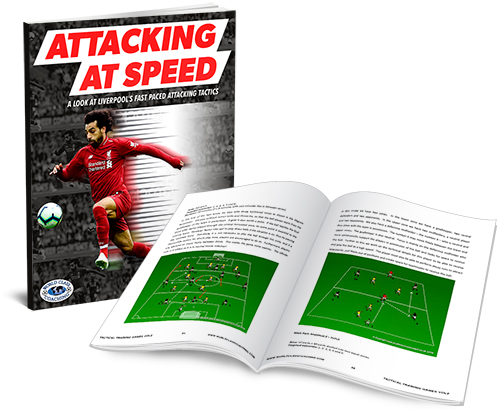
Table of Contents
PART THREE
Liverpool's Tactical Issues
Second Game Attacking Data and Key Factors
Liverpool's Tactical Issues
It was progressing the ball into the next line that Liverpool found difficult.
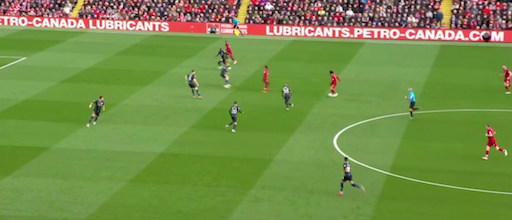
All the forward passing solution were often closed; Salah was in possession here, but any suitable forward passing chances could be exploited and the center backs of the opposition had to no attackers to mark on. To play forward this way was very difficult then.
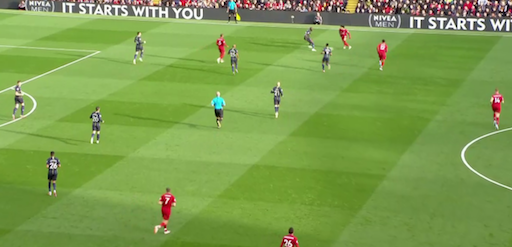
And the recovery of the ball, without initial pressure in the first third was quite easy for Manchester City.
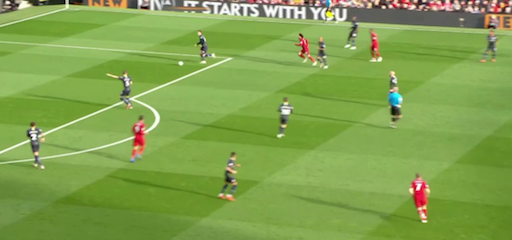
As we already analyzed, Liverpool looked dangerous only when they had regained possession high through pressing, like in this example, when Salah could face the goal and his usual direct opponent (Laporte) could be overcome.
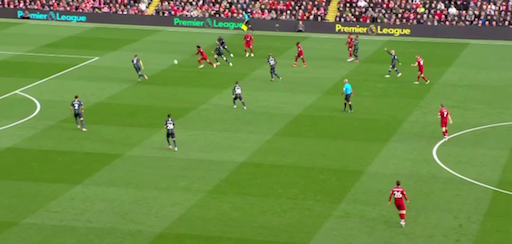
Again, the compactness of Man City defense often allowed the center backs to counter him before finishing, doubling the mark.
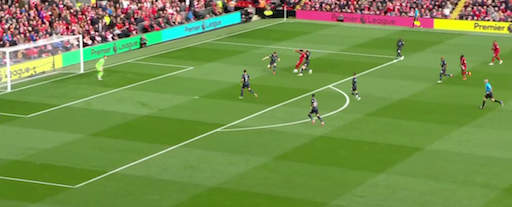
Mane and Firmino regularly dropped towards the ball from a high starting position, receiving between the lines after a switch of play, trying to force the defense line out of position. But this attacking trap didn't work well, as they were pressurized by the midfielder while retreating and not by the defenders while running up; they covered the depth against Salah, in this example.
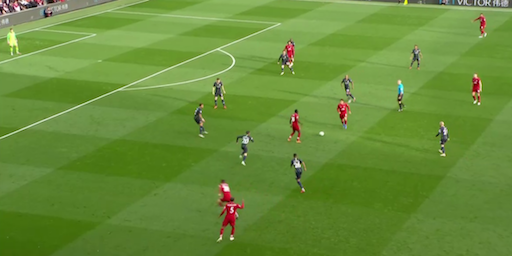
Thus a tactical issue was born when Firmino and Manè dropped too much back, during possession phases inside the final third, leaving Man City defenders without pressure. In the following picture, Firmino is placed on the midfield line and Manè was marked by Bernardo Silva. Laporte and Stones were without pressure and the opposition box could not be attacked properly. Salah could be double marked.
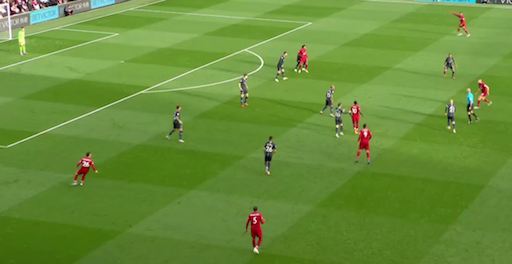
When Liverpool tried to play directly toward the advanced fullbacks, like in this situation, where Walker had to run out of position to cover Robertson and a space between the opposition right fullback and the center back was created,
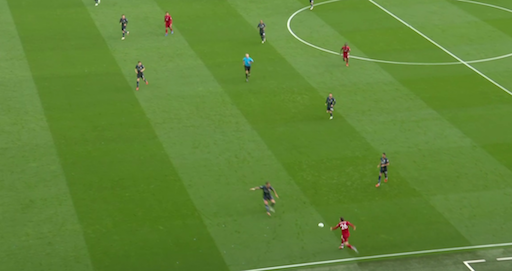
Man City did leave gaps to play through when shifting across,
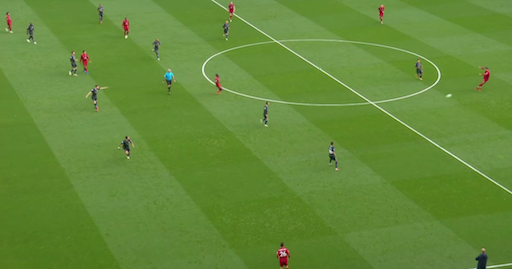
but again the compactness between the sectors and was solid, affording Liverpool minimal time and space on the ball to progress further.
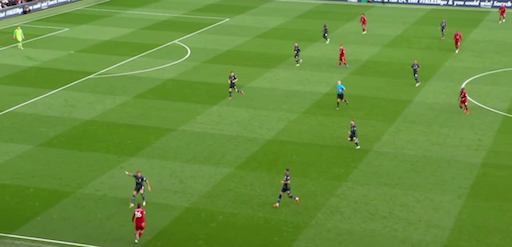
Even when it was possible to play near the opposition goal, the pressure made hard to play passes to create clear scoring chances.
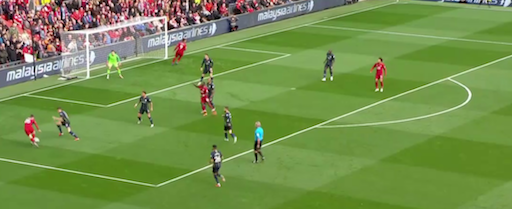
2nd leg possession and attacking data
The second Premier League match between Liverpool and Manchester City was not rich of tactical factors as the first one, but being an open play game, beside the final result, it became one of the most exciting matches of the last seasons; speed of play, players' energy and continuous transitions phases made these 90 minutes full of 1 v 1 duels and of pathos and emotions.
Liverpool and Manchester City players’ positions.
Liverpool's 1-4-3-3 was positioned with blocked center backs (Van Dijke - 4 and Lovren - 6), the fullbacks constantly pushing forward (Robertson - 26 and Trent Alexander Arnolds - 66), three close and flat midfielders (Henderson - 14, Wijnaldum - 5 and Milner - 7) and three close forwards (Manè - 10, Salah - 11 and Firimino - 9), overloading the center to leave space on the flanks for the fullbacks.
Manchester City 1-4-3-3-1 was very liquid as usual for Guardiola's teams. The center backs were blocked but placed high on the field (4 - Stones and 5 - Kompany), Danilo (3) completed the back three when in possession and Laporte (14) on the left side who played as pushing fullback and helping to overload the left side. Fernandinho (25) played as balance player; Bernardo Silva (20) and David Silva (21) were free to play when in possession. Sanè (19) and Sterling (7) had to provide width on the left and on the right sides, with Aguero as only center forward (10).
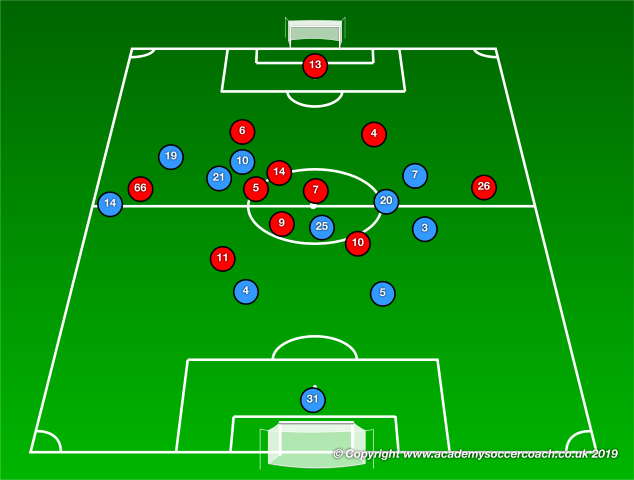
Actions zones:
The constant pressure created many changes in possession, frustrating both team’s creative ability due to several mistakes on the ball, or just losing the ball under pressure. Most of the game developed close to the middle of the field without clear goal scoring chances.
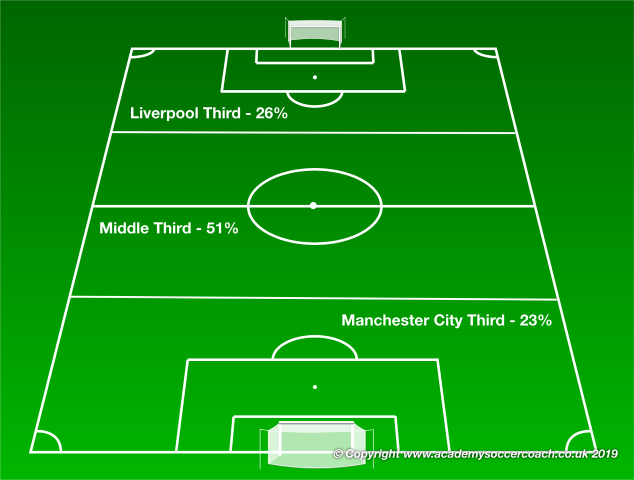
The hit map shows as Liverpool tended to play along the right side while building up and how then tried to exploit the whole width of the attacking third, switching sides to move the opposition defense. Manchester City overloaded the flanks before trying to finish from the left and right sided of 18y box.
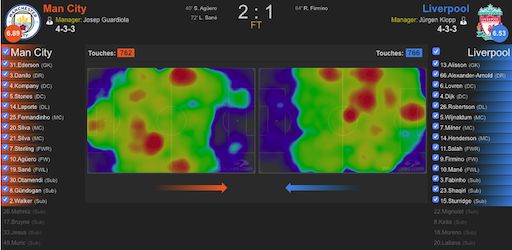
Match Statistics: looking at the general statistics, again general balance is very clear. By the way, the number of passes and moreover the key passes (that were totally absent in the first leg), and the quantity of lost balls show as the second leg was a freer from tactics, with open play and both the teams trying to win. Aerial duels were again a key factor, as Liverpool used them because of the opposition pressure and as tactical attacking choice to switch the sides of play.
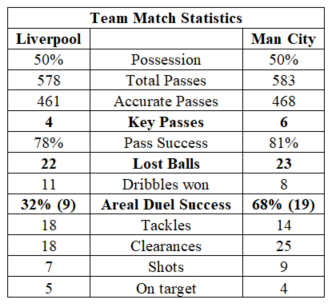
Attacking Sides: as we already saw before in the heat map, Liverpool build up on the right side, but the attacking moves were substantially distributed among the flanks (with a preference for the right side) and the center space of the final third. Manchester City was more confortable in finishing along the left flank due to the overload of that field zone, exploiting the skills of Sanè and Silva in finding spaces through quick combination play.
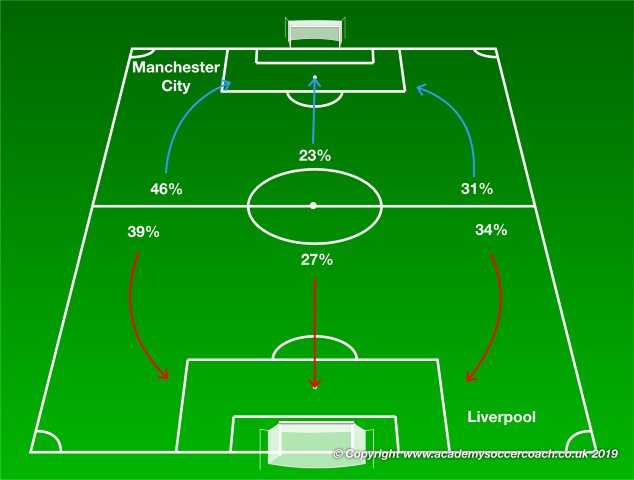
The increased number of forward passes, if it's compared with the first leg, confirms that the second match was played through more open spaces, created by the high rhythm of possession and the continuous transitions to attack and to defend.
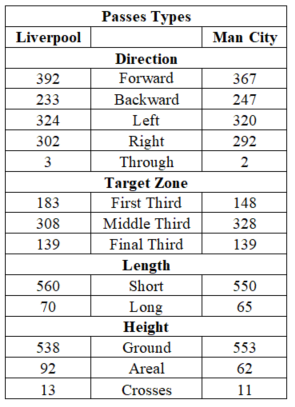
Looking at the chalkboard of the passes distribution, it's possible to notice how the match was played on the flanks (right one more than the left) to build up and overloading the center in the final third by Liverpool, and building up throughout the center of the middle third and overloading the left flank to finish by Manchester City.
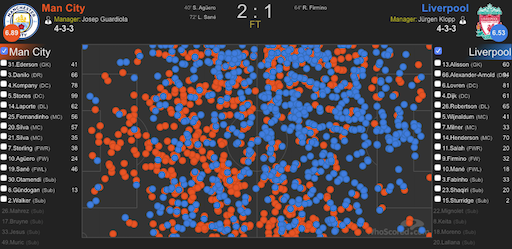
The heat map of dribbles actions confirms as Liverpool built up on the right side and tried to finish from the left one, overloading the center of the opposition defense block. Manchester City dribbled along both the flanks, on the right one more than along the left one (Sterling was free to dribble up rather than to combine with the teammates), as the left one was used to create numerical advantage situations to finish.
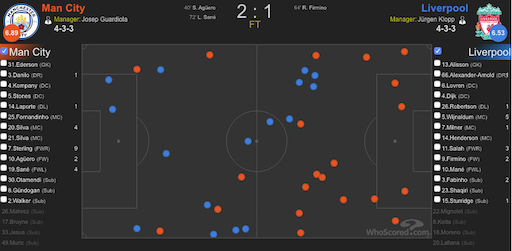
Finishing Zones: Liverpool tried to finish nearer the opposition goal than in the first leg through diagonal passes toward the box or through key passes in behind, when the opposition pressure could be avoided. The overload of the center in the final third is again confirmed. Manchester City finishing options were created inside the 18y box and outside the box to exploit the advanced midfielders and wingers support.
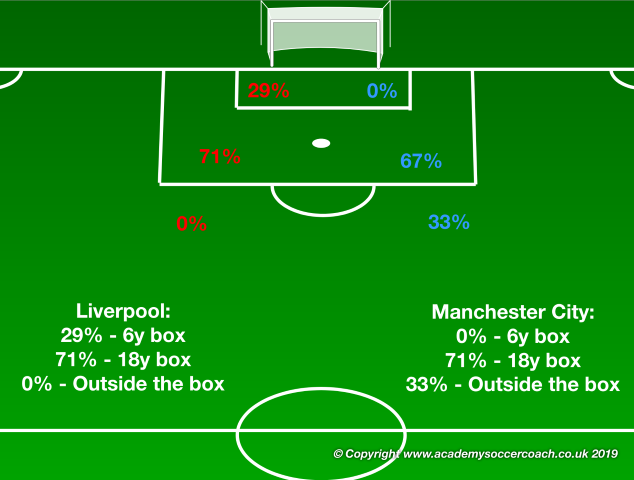
The clearances heat map shows how Liverpool tried to finish inside the box and near the opposition more than in the first leg. Manchester City tended to finish inside the box, but they tried also from outside the box, not using their well-known zone 14 to shot.
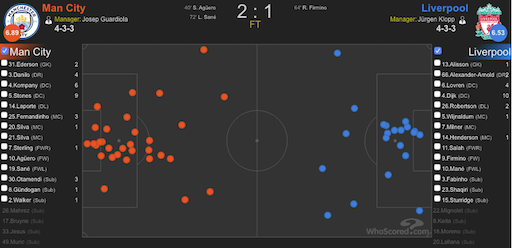
Shots Direction: Liverpool tended to finish along the center-right sides of the final third as the left fullback is skilled to play cross passes rather than to finish. The poor right side finishing of Manchester City confirms the intention to play and to attack through the left side.
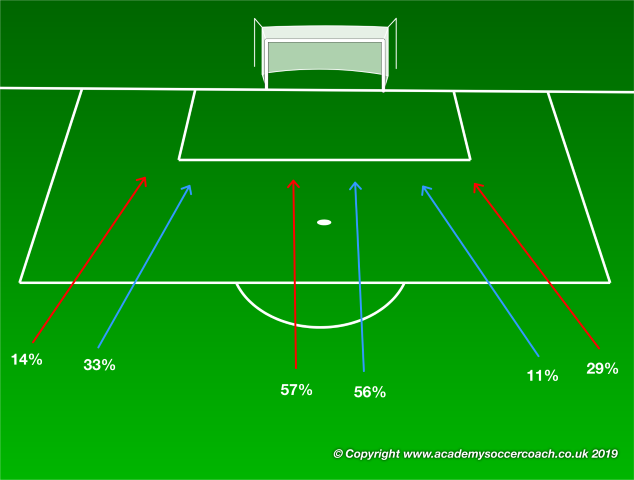
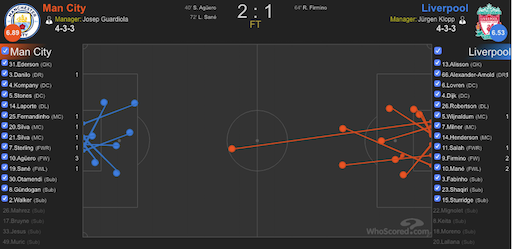
Goal succession:
Manchester City - Liverpool: 1 - 0 (Aguero)
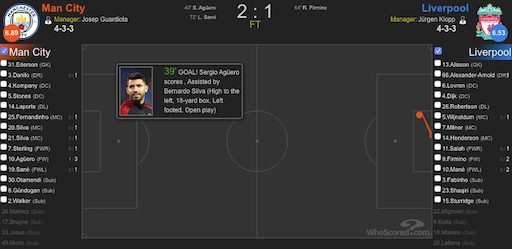
Manchester City - Liverpool: 1 - 1 (Firmino)
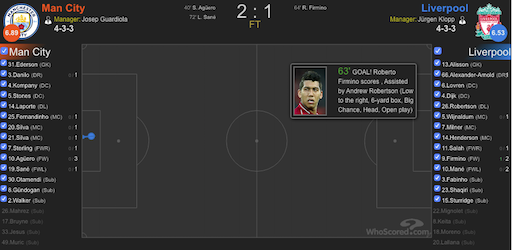
Manchester City - Liverpool: 2 - 1 (Sanè)
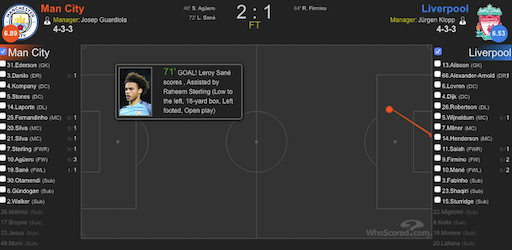
2nd leg general key factors
As usual, the Klopp 1-4-3-3 formation remained unchanged in possession and defensive phases. Due to the high and energetic pressure of Manchester City, they were unable to display the usual attacking rhythm, especially in the first half, having to sit deep and defend.
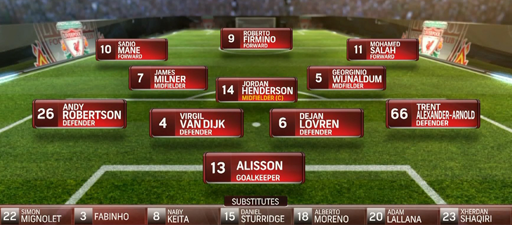
Liverpool defended Manchester City’s back four plus Fernandinho with six players and a flat three in midfield, forcing Wijnaldrum and Milner to cover the outer spaces overloads of Manchester City against Bernardo Silva and David Silva; this was the main tactics of Guardiola's team when in possession. Henderson in the middle of the midfield tried to counter the opponent holding midfielder Fernandinho.
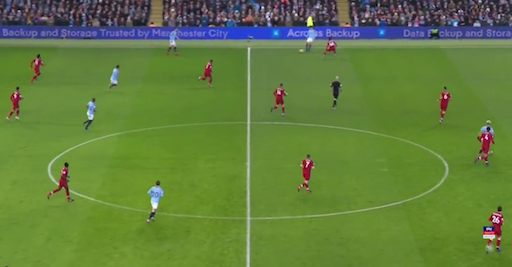
Klopp switched the formation into a 1-4-2-3-1 during the second half, when Fabinho (3) substituted Milner in the 57th minute and before the last two substitutions (Shaqiri - 23 and Sturridge - 15). Fabinho and Henderson played as double pivots with Wijnaldrum going to the left side. The change allowed Liverpool to defend the Manchester City back four and Fernandinho with four players and they avoided Man City attackers from getting deeper and between the lines.
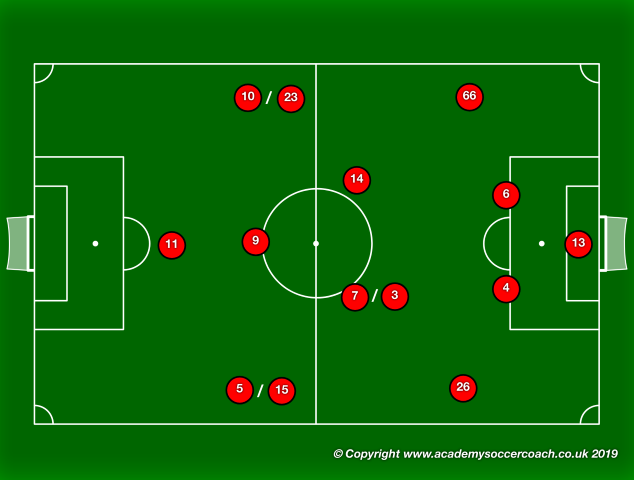
Pep Guardiola lined up as a 1-4-3-3, which is the usual structure of Manchester City. Fernandinho in the middle of midfield and David and Bernardo Silva were free to play around the pitch and to occupy the half spaces between the centre backs and fullbacks of the opposing team. Aymeric Laporte played as left fullback.
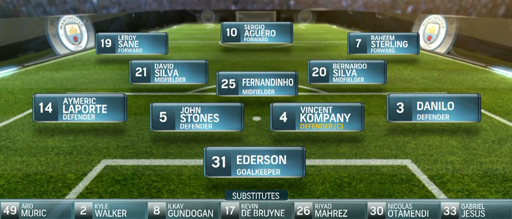
City was lined up as a 1-4-1-4-1 defense in the middle third and a 3-4-3 inside the first third, with Danilo pushing up and Laporte dropping in with Stones and Kompany. This compact shape allowed Guardiola's team to deal with Salah, Mane, and Firmino.
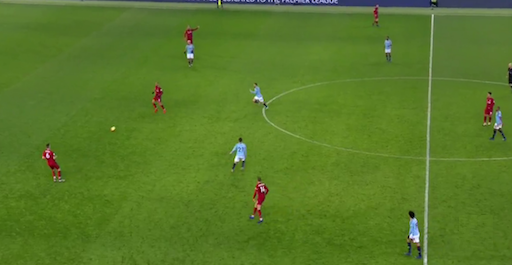
Laporte has the possession here, but the ball was just won back running up from the back three.



